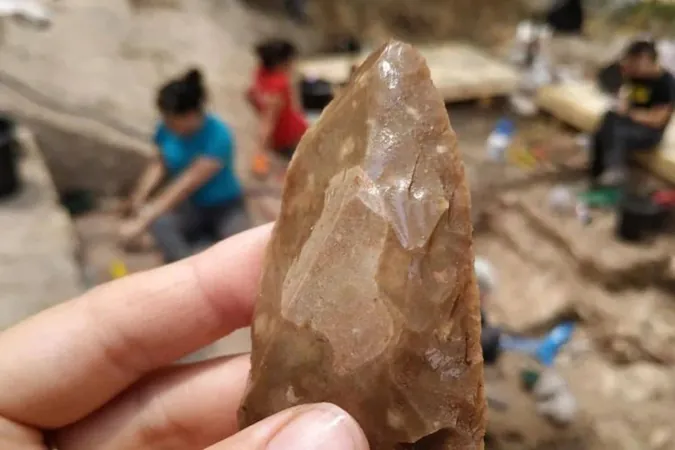
Groundbreaking Discovery: Neanderthals and Homo Sapiens Were Allies, Not Just Neighbors!
2025-03-28
Author: Ken Lee
In an astonishing twist to our understanding of prehistoric interactions, a recent study in *Nature Human Behaviour* reveals that Neanderthals and early Homo sapiens not only coexisted but also collaborated in significant ways. This groundbreaking research, led by Yossi Zaidner from the Hebrew University of Jerusalem, centered on findings from Tinshemet Cave in central Israel, suggesting a far more complex relationship than merely living side by side.
New Discoveries at Tinshemet Cave
Excavations at the Tinshemet Cave, which dates back roughly 110,000 years, have unveiled compelling evidence of cultural exchange between these two human species. The study showcases mutual practices in tool-making, burial rituals, and even signs of symbolic behavior—factors that challenge long-standing beliefs about their interactions.
This publication is pivotal as it marks the first scientific documentation of Tinshemet. The implications of these findings suggest that sourcing knowledge and methods might not have been a solitary journey for each species; rather, it appears they were engaged in a dialogue that ultimately enriched their cultural practices.
Cultural Collaboration Over Isolation
Historically, anthropologists fantasized about a world where Neanderthals and Homo sapiens thrived independently with minimal contact. However, the evidence from Tinshemet indicates a hybrid zone where cultural blending flourished.
Artifacts discovered, such as intricately crafted tools and ochre remnants, point to shared practices between the two groups. Both species appear to have engaged in similar burial customs, which now reframe our view on social behavior previously thought unique to Homo sapiens.
The presence of arranged skeletal remains alongside symbolic artifacts strongly suggests that mortuary practices were a communal endeavor, transforming our understanding of their social rituals.
The Levant Corridor: A Crucial Intersection
Strategically positioned within the Levantine corridor—a vital migration route connecting Africa, Asia, and Europe—Tinshemet Cave offers insights into why these two groups interacted. Dr. Marion Prévost, a co-author of the study, emphasizes that favorable climatic conditions during this period likely facilitated demographic expansion and intensified contacts among different human taxa.
Such dynamics created a convergence where behavioral similarities emerged not from parallel development but from shared experiences and interactions. This region, laden with history, can be envisioned as a melting pot of innovation, showcasing how collaboration spurred progress.
Impressive Evidence of Community Structures
Among the more astounding aspects of this research is the prospect that Tinshemet functioned as a communal burial site, hinting at a level of social organization previously unimagined for this period. If Neanderthals and Homo sapiens were indeed interring their dead together, this suggests far more profound social bonds than we’ve recognized.
Imagine early humans hunting side by side, sharing stories around a fire, and engaging in mutual support. As Professor Zaidner aptly states, “This cave and its contents illustrate that human connections and interactions have been intrinsic to driving cultural and technological progress throughout history.”
What Does This Mean for Our Understanding of Human Evolution?
These revolutionary findings reshape our narrative of human evolution, underscoring the importance of social bonds, shared practices, and cultural exchange not just in prehistory but also in shaping who we are today. As future research unfolds, the implications of Tinshemet could redefine relationships among early human species, proving that collaboration might have been a crucial factor in our survival and success as a species.
Prepare to dive deeper into the intricacies of human evolution, as new studies are poised to further unravel our shared past, revealing a history rich with cooperation rather than mere competition!


 Brasil (PT)
Brasil (PT)
 Canada (EN)
Canada (EN)
 Chile (ES)
Chile (ES)
 Česko (CS)
Česko (CS)
 대한민국 (KO)
대한민국 (KO)
 España (ES)
España (ES)
 France (FR)
France (FR)
 Hong Kong (EN)
Hong Kong (EN)
 Italia (IT)
Italia (IT)
 日本 (JA)
日本 (JA)
 Magyarország (HU)
Magyarország (HU)
 Norge (NO)
Norge (NO)
 Polska (PL)
Polska (PL)
 Schweiz (DE)
Schweiz (DE)
 Singapore (EN)
Singapore (EN)
 Sverige (SV)
Sverige (SV)
 Suomi (FI)
Suomi (FI)
 Türkiye (TR)
Türkiye (TR)
 الإمارات العربية المتحدة (AR)
الإمارات العربية المتحدة (AR)